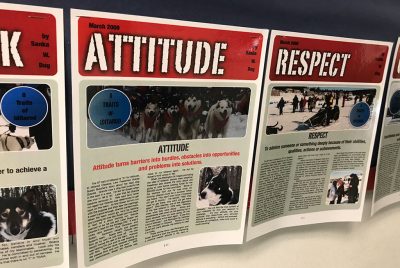
Kelly (Heffley) Villar ’06 MA, a second-grade teacher for the past 16 years at Southeast Elementary School in Mansfield, Conn., was selected as the Iditarod Teacher on the Trail for 2020.
A mother to six children ages 8 to 23, Villar is a longtime outdoorswoman and avid fan of the Iditarod, an annual sled dog race that covers 1,000 miles of terrain across Alaska, from Anchorage to Nome. Since 2000, the Teacher on the TrailTM program has selected one teacher each year to serve as the liaison between the trail and learners, creating lesson plans that are inspired by the real-life applications of the race and then made available online for all teachers.

The race officially began March 7, and Villar has been tracking her experience with blog posts and photos on the Iditarod’s Teacher on the Trail blog since arriving in Alaska in February. The following are excerpts from her ongoing Idiatrod blog:
March 7, 2020: Ceremonial Start
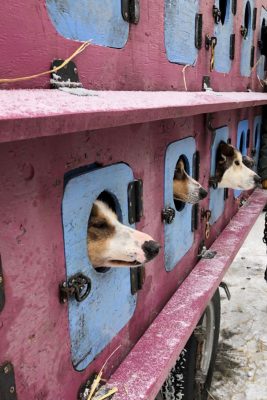
Today was the Ceremonial Start of the 2020 Iditarod in downtown Anchorage. I arrived in downtown several hours before the start and was able to enjoy the sights and sounds of the mushers preparing. Trucks, equipment, and dogs lined 4th Avenue and many of the side streets. I walked along listening to the sounds of the dogs excitedly barking and howling. As the lines, harnesses, and booties came out, you could feel the excitement in each dog. And when the time came for them to be harnessed up and clipped in, it was like an explosion. The dogs were pulling and jumping as if to say, “Can we go now! Now! Please! Please!” When the time came for them to run, they were ready!
The Ceremonial Start of the Iditarod is held on the first Saturday in March in downtown Anchorage. The mushers start at 4th and D [avenues] and run for 11 miles to Campbell Airstrip. During this run, mushers also carry an Iditarider in their sleds. Fans can bid to be an Iditarider each year. This exciting event draws thousands to downtown Anchorage each year!
This year I was lucky enough to ride with bib number 17 Gabe Dunham. It was an amazing 11 miles! I could feel the energy and excitement not only from the dogs but from the fans cheering Gabe on as we made our way to Campbell Airstrip. The fans had tailgates, cheered, [and] passed out hotdogs and lunch bags filled with treats. It was an awesome celebration for the mushers before they start their journey tomorrow toward Nome.
“The common theme is how cold the trail has been. Several mushers mentioned -43 [degrees Fahrenheit] … at night and very windy conditions. Being from Connecticut these temperatures are new for me, and I admire the strength they have to not only care for themselves, but to put the care of their dogs first!”
March 9, 2020: And They’re Off …
Snow was falling, the temperature was perfect, and the sounds of dogs barking and howling filled the air. The stage was set for the Re-Start of the Iditarod Trail Sled Dog Race, and it doesn’t get much better than this!
The talk of the morning was the snow. The incredible amount of snow on the ground and continuing to fall in Willow and along the first part of the trail. I was told today that the mushers will find 6 feet of snow in McGrath. How will the snow affect the race? It certainly can slow the trail down quite a bit. Already, on the tracker, we are seeing that the mushers are moving at a slower pace than last year by about 2 mph.
With all the mushers out of Willow, the journey begins along the trail. The first stop for these mushers is Yentna Station. Yentna is 53 miles from Willow, and the mushers will make it by this evening. The checkpoint is at Yentna Station Roadhouse the home of Dan and Jean Gabryszack. From there, they will follow the Yentna River until it meets the Swentna River. There the mushers will reach the 90-mile mark at the Skwenta Checkpoint. You can follow your favorite mushers as they begin their journey along the trail at the Iditarod homepage.
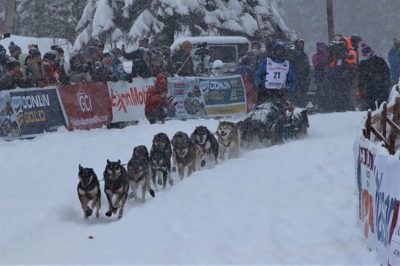
March 12, 2020: I’m in Takotna!
Next stop Takotna! It was a beautifully clear day, so the flight was spectacular. We even got an overhead view of several mushers heading into McGrath.
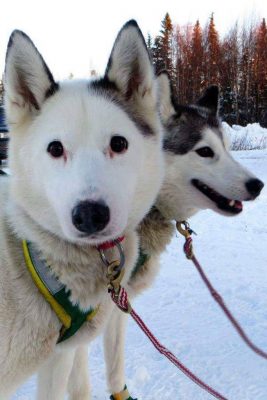
Takotna is a smaller village, population 51, located on the Takotna River. This village has been known by many different names in its history, Berry Landing, Portage City, Takotna City, Takotna Station, and Tocotna. At one point it had many stores that helped supply the gold miners. Today Takotna has one store, a post office, a beautiful school, and a church. It also has a small landing strip just outside the village.
Listening to the mushers who have rested in Nikolai and Takotna talk, the common theme is how cold the trail has been. Several mushers mentioned -43 [degrees Fahrenheit] at least at night and very windy conditions. Being from Connecticut these temperatures are new for me, and I admire the strength they have to not only care for themselves, but to put the care of their dogs first! Every musher has come in, bedded, fed, snuggled, and made sure their dogs were well taken care of and settled before they ate and warmed themselves.
March 16, 2020: Warming Up in Unalakleet
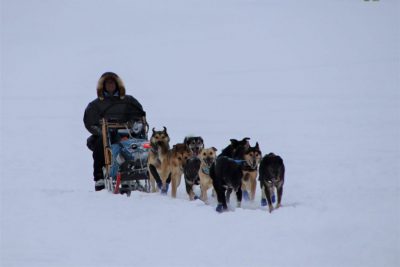
The sun is shining, temperatures in the mid 30s, and teams are steadily coming into Unalakleet. About half the teams have arrived now and many more will continue through the night. With these warmer temperatures, it could slow down a team. Mushers are taking extra care not to let their dogs overheat. Breaks and hydration are the key.
As the mushers leave they will head out over the ice of the Bering Sea and after Shaktoolik, Norton Sound. Weather was definitely on the minds of many mushers. With snow coming in tomorrow, I have heard several mushers mention the wind. If the gusts get to high, there can be white-out conditions. If the winds are coming from behind it could be an advantage. Always thinking ahead when it comes to the weather is important, even though it could change very quickly.
Follow Kelly Villar as she chronicles the race to the finish via her Iditarod Teacher on the TrailTM online Teacher’s Journal.
